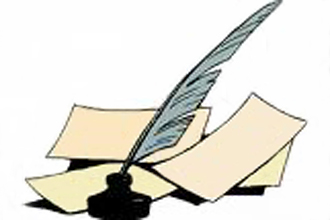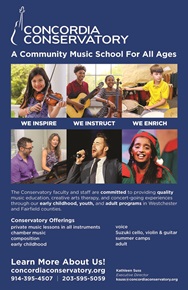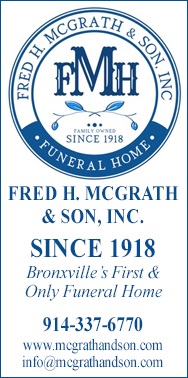Letter to the Editor: Dr. Mary Giuffra--It's Time to Focus on Academics

To the Editor:
In light of the Atlantic's 10/13 issue cover story, "How Sports are Ruining High School: The Real Reason U.S. Students Are Falling Behind," Dr. Thomas Wilson's statement in the recent issue of MyhometownBronxville that, despite a "tremendously creative investment in ideas" to expand after-school offerings, less than 50% of Bronxville middle school-aged students participate in 11 clubs, while 82.5% are involved in sports, concerns me.
Children are affected by our values: I support athletics; our four children played on Bronxville teams; our grandchildren are current athletes; "sports are embedded in American schools in a way they are not anywhere else" (Atlantic, 10/13); the challenge is to keep sports and academics in balance.
On 10/23/13, a New York Times editorial by Thomas Friedman notes that in Shanghai's best schools, a big chunk of time is spent learning from peers and personal development. As a result, the school attracts average people but gets enormous productivity from them.
In the same issue of the New York Times, the lead editorial notes that the US is falling behind and Americans are poorly skilled in comparison to competitors abroad. The culprit is not athletic skill but deficits in high-level math, science, and literary skills so necessary for the new economy. It is time to focus on academics and critical thinking.
Academic subjects and after-school activities demand as much board administration, parental time, and economic investment as sports activities. It is time to question our values. Our children's future demands nothing less.
It would be refreshing to see letters to the editor, comments, and articles about critical thinking and literary, art, and science clubs filled with the passion athletics has stimulated. Debate clubs are a fine way to teach critical thinking and debating skill. We could get just as excited watching our children think and defend positions using reason without attachment to personal desires. It would be fine preparation for their future success. Science club would teach students how to read research findings and draw reasonable conclusions from them.
Perhaps a board, faculty, parent, student, community committee might survey the school/community, identify expert coaches from various fields, develop a strategic plan in keeping with the Bronxville School mission, and create extra-curricular activities with a passion to excite our students about debating, decision making, research, law, health, poetry and literary activities, photography, film-making, etc. Let's truly educate the whole person, both in and out of the classroom.
Recalling Friedman's editorial explains that in Shanghai, a model for education and high in international ranking--US has dropped in rank to the low 40s--most of the learning is student to student and not teacher to student as it is in the US. The potential for learning through extra-curricular activities is ripe for exploration. Let's capitalize on the energy and passion that athletics has generated and use it to explore options that will ultimately make the difference in college acceptances.
Mary J. Giuffra, PhD
Bronxville, New York 10708
October 26, 2013
Editor's Note: MyhometownBronxville does not fact-check statements in letters to the editor, and the opinions do not necessarily reflect the thinking of its staff. Its objective in publishing letters to the editor is to give air to diverse thoughts and opinions of residents in the community.
Letters Directory
Bronxville is a quaint village (one square mile) located just 16 miles north of midtown Manhattan (roughly 30 minutes on the train) and has a population of approximately 6,500. It is known as a premier community with an excellent public school (K-12) and easy access to Manhattan. Bronxville offers many amenities including an attractive business district, a hospital (Lawrence Hospital), public paddle and tennis courts, fine dining at local restaurants, two private country clubs and a community library.
While the earliest settlers of Bronxville date back to the first half of the 18th century, the history of the modern suburb of Bronxville began in 1890 when William Van Duzer Lawrence purchased a farm and commissioned the architect, William A. Bates, to design a planned community of houses for well-known artists and professionals that became a thriving art colony. This community, now called Lawrence Park, is listed on the National register of Historic Places and many of the homes still have artists’ studios. A neighborhood association within Lawrence Park called “The Hilltop Association” keeps this heritage alive with art shows and other events for neighbors.
Bronxville offers many charming neighborhoods as well as a variety of living options for residents including single family homes, town houses, cooperatives and condominiums. One of the chief benefits of living in “the village” is that your children can attend the Bronxville School.
The Bronxville postal zone (10708, known as “Bronxville PO”) includes the village of Bronxville as well as the Chester Heights section of Eastchester, parts of Tuckahoe and the Lawrence Park West, Cedar Knolls, Armour Villa and Longvale sections of Yonkers. Many of these areas have their own distinct character. For instance, the Armour Villa section has many historic homes and even has its own newsletter called “The Villa Voice” which reports on neighborhood news.
Village of Bronxville Administrative Offices
337-6500
Open 9:00am - 4pm excluding holidays and weekends
Bronxville Police Department
337-0500
Open 24 hours
Bronxville Parking Violations
337-2024
Open 9:00am - 4pm excluding holidays and weekends
Bronxville Fire Deparment
793-6400







